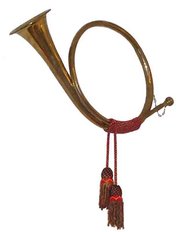
Serenade No. 9 (Mozart)
Encyclopedia

Post horn
The post horn is a valveless cylindrical brass or copper instrument with cupped mouthpiece, used to signal the arrival or departure of a post rider or mail coach...
, was written by Wolfgang Amadeus Mozart
Wolfgang Amadeus Mozart
Wolfgang Amadeus Mozart , baptismal name Johannes Chrysostomus Wolfgangus Theophilus Mozart , was a prolific and influential composer of the Classical era. He composed over 600 works, many acknowledged as pinnacles of symphonic, concertante, chamber, piano, operatic, and choral music...
in Salzburg
Salzburg
-Population development:In 1935, the population significantly increased when Salzburg absorbed adjacent municipalities. After World War II, numerous refugees found a new home in the city. New residential space was created for American soldiers of the postwar Occupation, and could be used for...
, in 1779. The manuscript is dated 3 August 1779 and was intended for the university
University of Salzburg
The University of Salzburg, or Paris Lodron University after its founder, the Prince Archbishop Paris Lodron, is located in the Austrian city of Salzburg, Salzburgerland, home of Mozart. It is divided into 4 faculties: catholic theology, law, humanities and natural science.Founded in 1622, it...
"finalmusik" ceremony that year.
The serenade is scored for 2 flute
Flute
The flute is a musical instrument of the woodwind family. Unlike woodwind instruments with reeds, a flute is an aerophone or reedless wind instrument that produces its sound from the flow of air across an opening...
s, flautino
Flautino
Flautino may refer to several high-pitched woodwind instruments:*Zuffolo*Sopranino recorder*Piccolo...
, 2 oboe
Oboe
The oboe is a double reed musical instrument of the woodwind family. In English, prior to 1770, the instrument was called "hautbois" , "hoboy", or "French hoboy". The spelling "oboe" was adopted into English ca...
s, 2 bassoon
Bassoon
The bassoon is a woodwind instrument in the double reed family that typically plays music written in the bass and tenor registers, and occasionally higher. Appearing in its modern form in the 19th century, the bassoon figures prominently in orchestral, concert band and chamber music literature...
s, 2 horns
Horn (instrument)
The horn is a brass instrument consisting of about of tubing wrapped into a coil with a flared bell. A musician who plays the horn is called a horn player ....
, 2 trumpet
Trumpet
The trumpet is the musical instrument with the highest register in the brass family. Trumpets are among the oldest musical instruments, dating back to at least 1500 BCE. They are played by blowing air through closed lips, producing a "buzzing" sound which starts a standing wave vibration in the air...
s, post horn
Post horn
The post horn is a valveless cylindrical brass or copper instrument with cupped mouthpiece, used to signal the arrival or departure of a post rider or mail coach...
, timpani
Timpani
Timpani, or kettledrums, are musical instruments in the percussion family. A type of drum, they consist of a skin called a head stretched over a large bowl traditionally made of copper. They are played by striking the head with a specialized drum stick called a timpani stick or timpani mallet...
and strings
String instrument
A string instrument is a musical instrument that produces sound by means of vibrating strings. In the Hornbostel-Sachs scheme of musical instrument classification, used in organology, they are called chordophones...
. It has seven movements
Movement (music)
A movement is a self-contained part of a musical composition or musical form. While individual or selected movements from a composition are sometimes performed separately, a performance of the complete work requires all the movements to be performed in succession...
:
- Adagio maestosoMaestosoMaestoso is an Italian musical term and is used to direct performers to play a certain passage of music in a stately, dignified and majestic fashion or, it is used to describe music as such. The term is commonly used in relatively slow pieces; however, there are numerous examples - such as the...
- Allegro con spirito - Minuetto
- Concertante: Andante grazioso in G majorG majorG major is a major scale based on G, with the pitches G, A, B, C, D, E, and F. Its key signature has one sharp, F; in treble-clef key signatures, the sharp-symbol for F is usually placed on the first line from the top, though in some Baroque music it is placed on the first space from the bottom...
- RondeauRondoRondo, and its French equivalent rondeau, is a word that has been used in music in a number of ways, most often in reference to a musical form, but also to a character-type that is distinct from the form...
: Allegro ma non troppo in G majorG majorG major is a major scale based on G, with the pitches G, A, B, C, D, E, and F. Its key signature has one sharp, F; in treble-clef key signatures, the sharp-symbol for F is usually placed on the first line from the top, though in some Baroque music it is placed on the first space from the bottom... - Andantino in D minorD minorD minor is a minor scale based on D, consisting of the pitches D, E, F, G, A, B, and C. In the harmonic minor, the C is raised to C. Its key signature has one flat ....
- Minuetto - Trio 1 & 2
- Finale: Presto
The Concertante and Rondeau movements feature prominent concertante sections for flute and oboe.
The first trio of the second minuet features a solo flautino
Flautino
Flautino may refer to several high-pitched woodwind instruments:*Zuffolo*Sopranino recorder*Piccolo...
(or piccolo) played over strings. The second trio of the second minuet features a solo for the post horn
Post horn
The post horn is a valveless cylindrical brass or copper instrument with cupped mouthpiece, used to signal the arrival or departure of a post rider or mail coach...
. This solo gives the serenade its nickname.
A typical performance lasts approximately 45 minutes.

